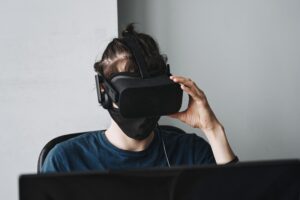Artificial Intelligence (AI) has revolutionized various industries, and video production is no exception. AI has become an integral part of the video production process, offering innovative solutions and enhancing efficiency. By leveraging AI technologies, video producers can automate tasks, improve editing techniques, and create engaging content. The importance of AI in video production cannot be overstated, as it allows for faster turnaround times, cost savings, and improved quality.
Understanding the Basics of AI and Machine Learning
AI refers to the simulation of human intelligence in machines that are programmed to think and learn like humans. Machine learning is a subset of AI that focuses on enabling machines to learn from data without being explicitly programmed. In video production, AI and machine learning are used to analyze vast amounts of data, recognize patterns, and make predictions.
AI and machine learning are used in various ways in video production. For example, AI algorithms can analyze video footage to identify objects, faces, or specific scenes. This enables video producers to automate tasks such as tagging or categorizing videos. Machine learning algorithms can also be used to improve video editing techniques by analyzing user preferences and creating personalized content.
Types of AI Techniques for Video Production
There are several AI techniques used in video production, each with its own unique capabilities. One common technique is computer vision, which involves training AI models to recognize and understand visual data. This technique is used for object detection and tracking in videos, allowing for automated analysis and editing.
Another technique is natural language processing (NLP), which enables machines to understand and interpret human language. NLP can be used in video production to automatically generate subtitles or captions based on the audio content of a video.
Generative adversarial networks (GANs) are another powerful AI technique used in video production. GANs consist of two neural networks: a generator network that creates new content, and a discriminator network that evaluates the generated content. This technique can be used to create realistic deepfake videos or generate new video content based on existing footage.
Data Collection and Pre-Processing for AI Training
Data collection and pre-processing are crucial steps in training AI models for video production. High-quality and diverse datasets are essential for training accurate and robust AI models. Video producers need to collect and curate large amounts of data, including videos, images, and metadata.
Data pre-processing involves cleaning and preparing the collected data for training. This may include removing noise, normalizing data, or augmenting the dataset to increase its diversity. Pre-processing techniques such as resizing, cropping, or converting video formats are also used to ensure compatibility with AI models.
Selecting the Right AI Model for Video Production
When selecting an AI model for video production, several factors need to be considered. The specific requirements of the project, the available resources, and the desired outcomes all play a role in choosing the right AI model.
There are various AI models used in video production, each with its own strengths and limitations. For example, convolutional neural networks (CNNs) are commonly used for object detection and tracking in videos. Recurrent neural networks (RNNs) are often used for analyzing sequential data, such as speech or subtitles in videos.
Transfer learning is another approach that can be used in video production. This involves using pre-trained AI models and fine-tuning them for specific tasks. Transfer learning can save time and resources by leveraging existing knowledge from pre-trained models.
Training AI for Object Detection and Tracking in Video

Object detection and tracking are essential tasks in video production, enabling automated analysis and editing. AI algorithms can be trained to detect and track objects in videos by analyzing frames or sequences of frames.
To train AI models for object detection and tracking, labeled datasets are required. These datasets consist of videos or images with annotated bounding boxes around the objects of interest. The AI model is then trained to recognize and track these objects based on the provided annotations.
Once trained, the AI model can be used to automatically detect and track objects in new videos. This can be particularly useful in applications such as video surveillance, sports analysis, or content categorization.
AI-based Video Editing Techniques and Strategies
AI has greatly enhanced video editing techniques and strategies, allowing for more efficient and creative workflows. AI algorithms can analyze video footage, identify key moments, and automatically generate highlight reels or trailers.
One example of AI-based video editing technique is automated shot selection. AI algorithms can analyze video footage and select the best shots based on factors such as composition, lighting, or action. This saves time for video editors and ensures that the final product is visually appealing.
AI can also be used for automated color correction, where algorithms analyze the color balance and lighting conditions of a video and make adjustments to improve the overall visual quality. This eliminates the need for manual color grading and ensures consistent color representation across different scenes.
Implementing AI for Automated Video Content Creation
Automated video content creation is another area where AI has made significant advancements. AI algorithms can generate new video content based on existing footage or user preferences. This allows for personalized video recommendations, targeted advertising, or even automated storytelling.
For example, AI algorithms can analyze user preferences and viewing habits to generate personalized video playlists or recommendations. This enhances the user experience by providing relevant content tailored to individual interests.
AI can also be used to automate the process of creating video content from scratch. By analyzing existing videos or images, AI algorithms can generate new videos with specific themes or styles. This opens up new possibilities for content creators and allows for more efficient content production.
Evaluating the Performance of AI in Video Production
Evaluating the performance of AI models in video production is crucial to ensure their accuracy and reliability. Several metrics can be used to evaluate the performance of AI models, depending on the specific task and requirements.
For object detection and tracking, metrics such as precision, recall, and F1 score are commonly used. Precision measures the percentage of correctly detected objects, while recall measures the percentage of objects that were correctly detected out of all the objects present. The F1 score is a combination of precision and recall, providing an overall measure of the model’s performance.
For video editing techniques, metrics such as user engagement or click-through rates can be used to evaluate the effectiveness of AI-generated content. User feedback and subjective evaluations are also important in assessing the quality and relevance of AI-generated videos.
Future of AI in Video Production and its Implications
The future of AI in video production is promising, with continued advancements in technology and increased adoption across the industry. AI has the potential to revolutionize content creation, making it more efficient, personalized, and engaging.
However, the widespread use of AI in video production also raises ethical concerns. Deepfake videos, for example, can be used to manipulate or deceive viewers. It is crucial to develop robust algorithms and ethical guidelines to ensure responsible use of AI in video production.
In conclusion, AI has become an integral part of video production, offering innovative solutions and enhancing efficiency. By leveraging AI technologies, video producers can automate tasks, improve editing techniques, and create engaging content. However, it is important to carefully consider the implications and ethical considerations associated with the use of AI in video production. With responsible implementation and continuous advancements in technology, AI has the potential to transform the industry and shape the future of video production.
If you’re interested in learning more about training AI to make videos, you might find the article “Synthetic Media: The Future of Content Creation” on aitv.media quite intriguing. This insightful piece delves into the fascinating world of synthetic media and how AI is revolutionizing content creation. From deepfakes to virtual influencers, this article explores the potential and ethical implications of AI-generated videos. Check it out here for an in-depth look at this cutting-edge technology.



